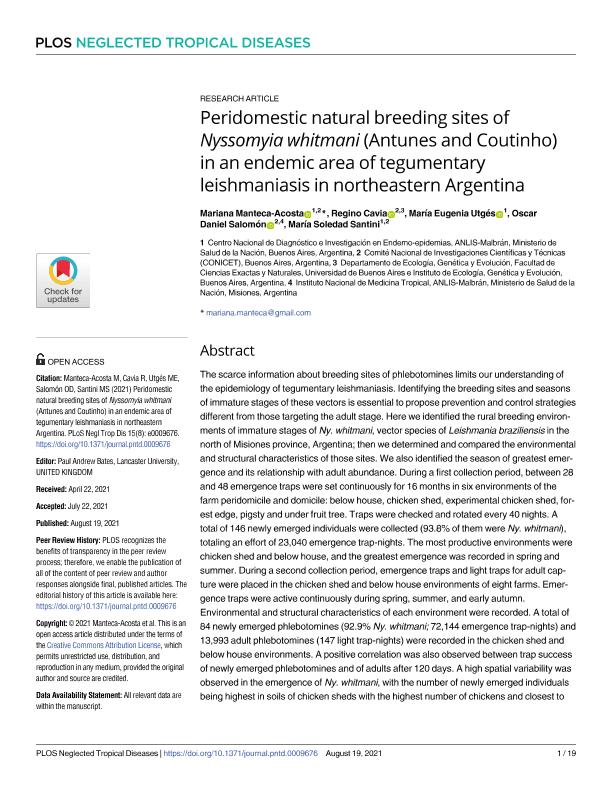Mostrar el registro sencillo del ítem
dc.contributor.author
Manteca Acosta, Mariana

dc.contributor.author
Cavia, Regino

dc.contributor.author
Utgés, María Eugenia

dc.contributor.author
Salomón, Oscar Daniel

dc.contributor.author
Santini, Maria Soledad

dc.date.available
2022-02-24T17:51:13Z
dc.date.issued
2021-08
dc.identifier.citation
Manteca Acosta, Mariana; Cavia, Regino; Utgés, María Eugenia; Salomón, Oscar Daniel; Santini, Maria Soledad; Peridomestic natural breeding sites of Nyssomyia whitmani (Antunes and Coutinho) in an endemic area of tegumentary leishmaniasis in northeastern Argentina; Public Library of Science; Neglected Tropical Diseases; 15; 8; 8-2021; 1-19
dc.identifier.issn
1935-2735
dc.identifier.uri
http://hdl.handle.net/11336/152682
dc.description.abstract
The scarce information about breeding sites of phlebotomines limits our understanding of the epidemiology of tegumentary leishmaniasis. Identifying the breeding sites and seasons of immature stages of these vectors is essential to propose prevention and control strategies different from those targeting the adult stage. Here we identified the rural breeding environments of immature stages of Ny. whitmani, vector species of Leishmania braziliensis in the north of Misiones province, Argentina; then we determined and compared the environmental and structural characteristics of those sites. We also identified the season of greatest emergence and its relationship with adult abundance. During a first collection period, between 28 and 48 emergence traps were set continuously for 16 months in six environments of the farm peridomicile and domicile: below house, chicken shed, experimental chicken shed, forest edge, pigsty and under fruit tree. Traps were checked and rotated every 40 nights. A total of 146 newly emerged individuals were collected (93.8% of them were Ny. whitmani), totaling an effort of 23,040 emergence trap-nights. The most productive environments were chicken shed and below house, and the greatest emergence was recorded in spring and summer. During a second collection period, emergence traps and light traps for adult cap-ture were placed in the chicken shed and below house environments of eight farms. Emergence traps were active continuously during spring, summer, and early autumn. Environmental and structural characteristics of each environment were recorded. A total of 84 newly emerged phlebotomines (92.9% Ny. whitmani; 72,144 emergence trap-nights) and 13,993 adult phlebotomines (147 light trap-nights) were recorded in the chicken shed and below house environments. A positive correlation was also observed between trap success of newly emerged phlebotomines and of adults after 120 days. A high spatial variability was observed in the emergence of Ny. whitmani, with the number of newly emerged individuals being highest in soils of chicken sheds with the highest number of chickens and closest to forest edge. Moreover, below house was found to be as important as chicken sheds as breeding sites of Ny. whitmani. Management of the number of chickens in sheds, soil mois-ture and pH, and the decision of where to localize the chicken sheds in relation to the houses and the forest edge, might contribute to reduce the risk of human vector exposure and transmission of Leishmania.
dc.format
application/pdf
dc.language.iso
eng
dc.publisher
Public Library of Science

dc.rights
info:eu-repo/semantics/openAccess
dc.rights.uri
https://creativecommons.org/licenses/by/2.5/ar/
dc.subject
CUTANEOUS LEISHMANIASIS
dc.subject
PHLEBOTOMINAE
dc.subject
BREEDING
dc.subject
Ny WHITMANI
dc.subject.classification
Medicina Tropical

dc.subject.classification
Ciencias de la Salud

dc.subject.classification
CIENCIAS MÉDICAS Y DE LA SALUD

dc.title
Peridomestic natural breeding sites of Nyssomyia whitmani (Antunes and Coutinho) in an endemic area of tegumentary leishmaniasis in northeastern Argentina
dc.type
info:eu-repo/semantics/article
dc.type
info:ar-repo/semantics/artículo
dc.type
info:eu-repo/semantics/publishedVersion
dc.date.updated
2022-01-20T13:10:47Z
dc.journal.volume
15
dc.journal.number
8
dc.journal.pagination
1-19
dc.journal.pais
Estados Unidos

dc.description.fil
Fil: Manteca Acosta, Mariana. Consejo Nacional de Investigaciones Científicas y Técnicas; Argentina. Dirección Nacional de Instituto de Investigación.Administración Nacional de Laboratorios e Institutos de Salud "Dr. Carlos G. Malbrán"; Argentina
dc.description.fil
Fil: Cavia, Regino. Universidad de Buenos Aires. Facultad de Ciencias Exactas y Naturales; Argentina. Consejo Nacional de Investigaciones Científicas y Técnicas; Argentina
dc.description.fil
Fil: Utgés, María Eugenia. Consejo Nacional de Investigaciones Científicas y Técnicas; Argentina. Dirección Nacional de Instituto de Investigación.Administración Nacional de Laboratorios e Institutos de Salud "Dr. Carlos G. Malbrán"; Argentina
dc.description.fil
Fil: Salomón, Oscar Daniel. Consejo Nacional de Investigaciones Científicas y Técnicas; Argentina. Administración Nacional de Laboratorios e Institutos de Salud "Dr. Carlos G. Malbrán". Instituto Nacional de Medicina Tropical; Argentina
dc.description.fil
Fil: Santini, Maria Soledad. Consejo Nacional de Investigaciones Científicas y Técnicas; Argentina. Dirección Nacional de Instituto de Investigación.Administración Nacional de Laboratorios e Institutos de Salud "Dr. Carlos G. Malbrán"; Argentina
dc.journal.title
Neglected Tropical Diseases

dc.relation.alternativeid
info:eu-repo/semantics/altIdentifier/doi/http://dx.doi.org/10.1371/journal.pntd.0009676
dc.relation.alternativeid
info:eu-repo/semantics/altIdentifier/url/https://journals.plos.org/plosntds/article?id=10.1371/journal.pntd.0009676
Archivos asociados
